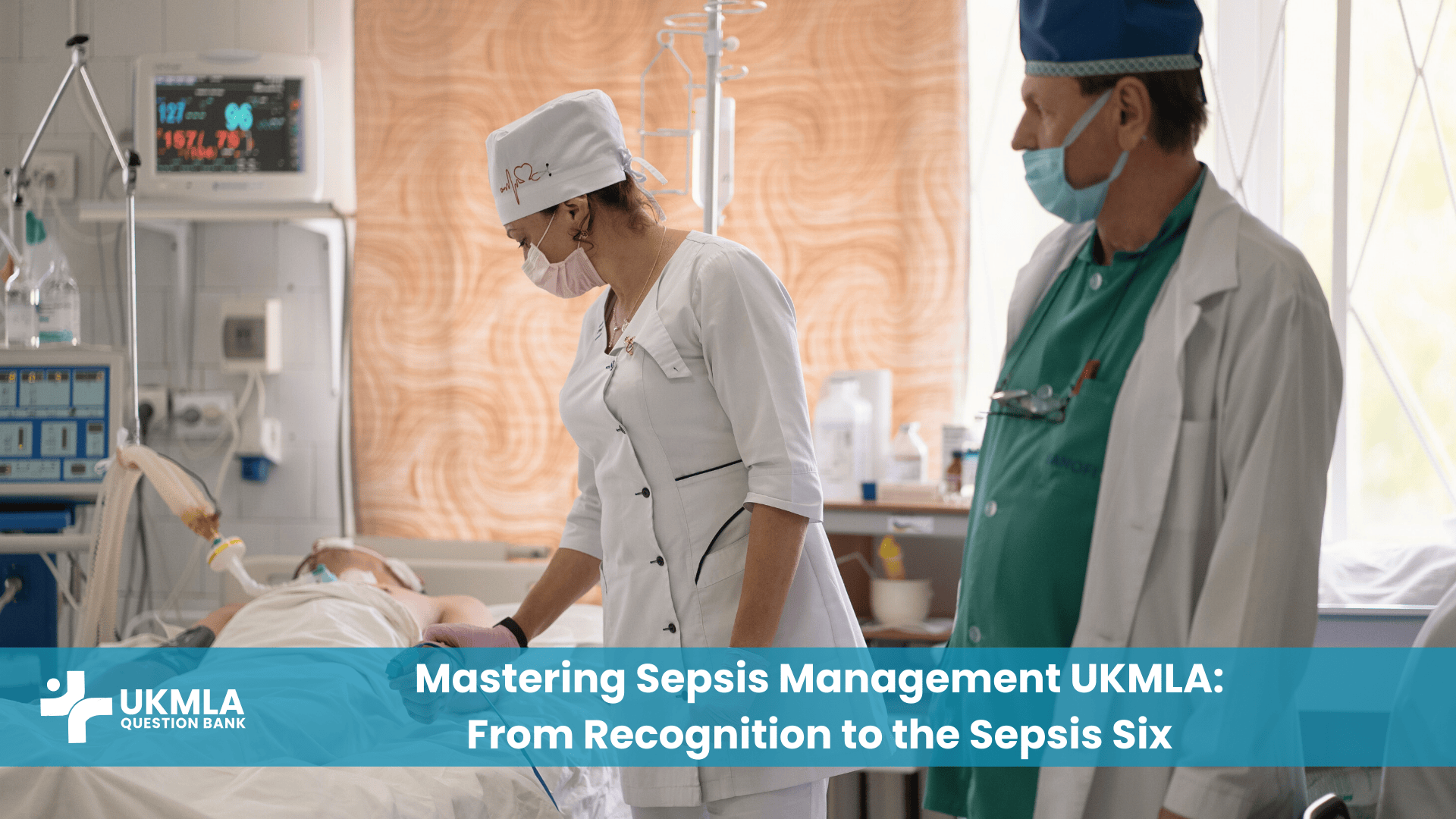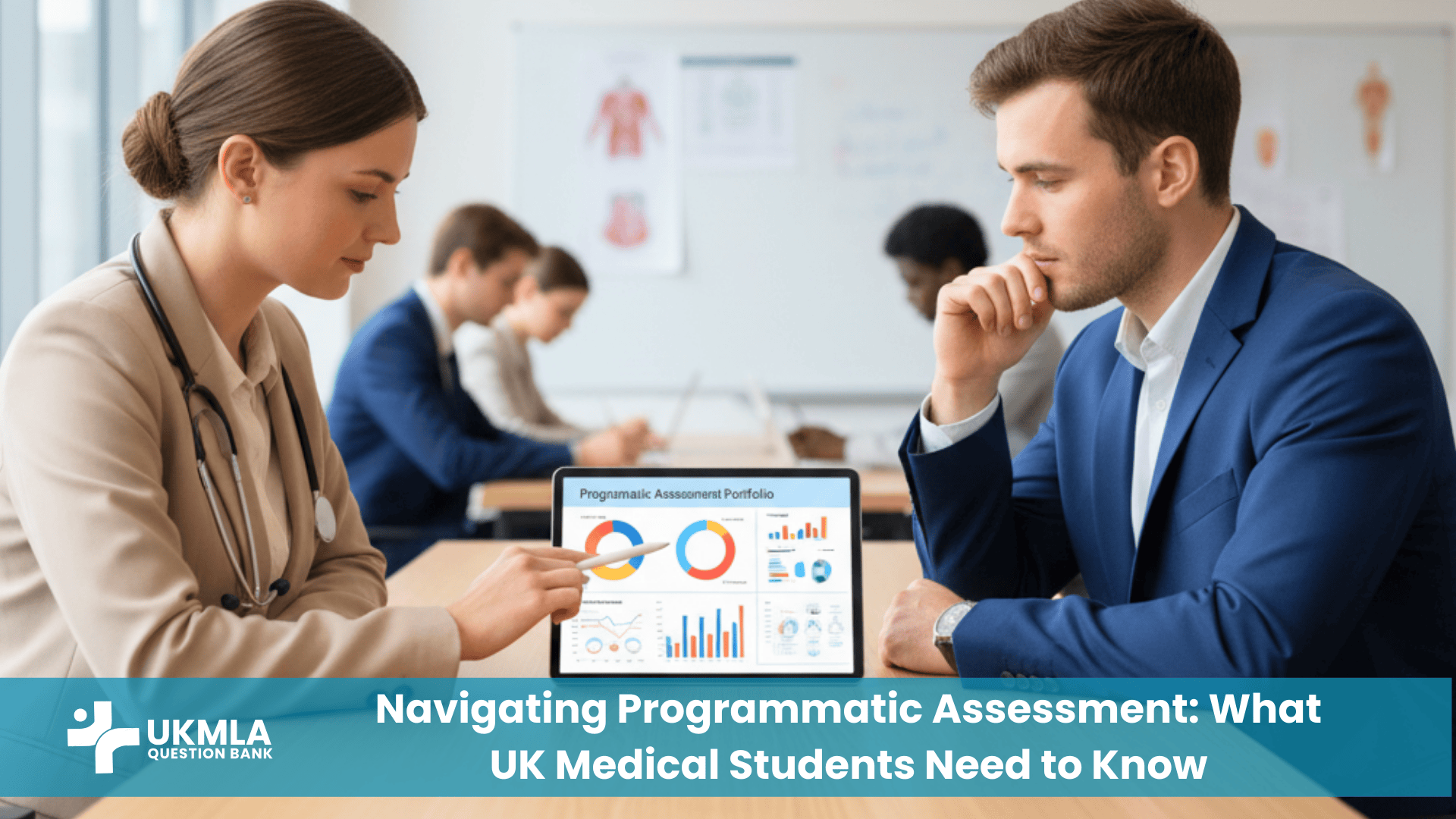Introduction
Sepsis management UKMLA is one of the most critical, high-yield topics you will encounter. As a time-critical medical emergency, sepsis is a condition where a swift, systematic approach can mean the difference between life and death. For this reason, the UKMLA—across both the AKT and CPSA—heavily scrutinizes your ability to recognise a deteriorating patient, escalate appropriately, and initiate timely, life-saving interventions. This is a core competency in UKMLA emergency medicine.
This guide will provide a clear, 5-step framework for mastering sepsis, from initial suspicion to the correct implementation of the Sepsis Six pathway. The goal is to move beyond rote memorization of the six steps and build a deep, practical understanding of the principles that underpin effective sepsis care. By internalizing this process, you will be well-equipped to handle sepsis scenarios with the confidence and competence required for exam success and, more importantly, for safe and effective clinical practice.
Table of Contents
ToggleSepsis Management UKMLA: A Step-by-Step Guide
Step 1: Recognition and Suspicion
The first and most crucial step in managing sepsis is recognizing it early. Sepsis can present with vague and non-specific symptoms, making it a diagnostic challenge. The modern Sepsis-3 definition describes sepsis as a “life-threatening organ dysfunction caused by a dysregulated host response to infection.” The key is to look for signs of organ dysfunction in a patient with a suspected infection. The definitive UK resource for this is the NICE guideline on Sepsis.
In the UK, the primary tool for identifying deteriorating patients on the ward is the NEWS2 (National Early Warning Score 2). A NEWS2 score of 5 or more is a key trigger to consider sepsis. It is vital to understand that the signs of sepsis are considered red flag symptoms for the UKMLA. Your ability to act on these scores is a key part of interpreting clinical data for the UKMLA AKT.
Table 1: Key Signs of Organ Dysfunction in Sepsis
| System | Sign / Symptom | What to Look For |
|---|---|---|
| Cardiovascular | Hypotension | Systolic BP < 100 mmHg or a significant drop from baseline. |
| Respiratory | Tachypnoea / Hypoxia | Respiratory rate > 22, needing oxygen to maintain saturations. |
| Neurological | Altered Mental State | New confusion, agitation, or a drop in GCS score. |
| Renal | Oliguria / AKI | Low urine output (<0.5 ml/kg/hr), rising creatinine. |
| Haematological | Coagulopathy | Low platelet count, raised INR. |
| Metabolic | Lactic Acidosis | A serum lactate level > 2 mmol/L. |
Step 2: Immediate Escalation and A-E Assessment
Once you suspect sepsis based on clinical signs or a high NEWS2 score, you must act immediately. Your first action is not to order tests, but to escalate.
According to The UK Sepsis Trust: “Just ask: could it be sepsis? It’s a simple question that could save a life. Early recognition and treatment are key to improving outcomes.”
As a junior doctor, you must inform a senior colleague—your registrar or the on-call medical consultant—immediately. This is a safety-critical step. While awaiting their review, you should perform a rapid A-E (Airway, Breathing, Circulation, Disability, Exposure) assessment to identify and address any immediate life threats.
Step 3: Resuscitation (The ‘Give’ Interventions)
This step focuses on the immediate, life-saving “give” interventions from the Sepsis Six bundle. These actions are designed to correct hypoxia and hypoperfusion.
Give Oxygen: Administer high-flow oxygen via a non-rebreathe mask to maintain oxygen saturations between 94-98% (or 88-92% in patients at risk of hypercapnic respiratory failure, e.g., COPD).
Give IV Fluids: Start a fluid challenge with a bolus of intravenous crystalloid (e.g., 500ml of Hartmann’s or 0.9% saline over 15 minutes) for patients with hypotension (SBP < 90 mmHg) or evidence of hypoperfusion (e.g., lactate > 2).
Step 4: Investigation and Treatment (The ‘Take’ & Treat Interventions)
Running concurrently with resuscitation, this step focuses on identifying the cause and starting definitive treatment.
Take Blood Cultures: Before administering antibiotics, take at least two sets of blood cultures from different sites. This is crucial for identifying the causative organism and tailoring antibiotic therapy later. You should also take other relevant cultures (e.g., urine, sputum) based on the likely source.
Take Lactate: A serum lactate level is a key marker of end-organ hypoperfusion and tissue hypoxia. A high or rising lactate is a strong indicator of severe illness and is used to track response to resuscitation.
Give IV Antibiotics: Administer broad-spectrum intravenous antibiotics according to your local hospital’s formulary and guidelines. Do not delay this step. This is a critical intervention where your knowledge of high-yield pharmacology for the UKMLA is key.
Step 5: Monitoring and Reassessment (Completing the Bundle and Beyond)
The final step of the Sepsis Six is to monitor the patient’s response to your initial interventions.
Measure Urine Output: Insert a urinary catheter to accurately monitor hourly urine output. Oliguria (<0.5 ml/kg/hr) is an early and sensitive sign of acute kidney injury (AKI) due to sepsis.
After the full Sepsis Six bundle is delivered, continuous reassessment is vital. This includes reassessing the patient’s A-E, vital signs, and their response to the fluid bolus. The goal is to identify the source of the infection and implement “source control” measures (e.g., draining an abscess). If the patient remains unstable, they require urgent escalation to the critical care team.
Table 2: The Sepsis Six Interventions Checklist
| Bundle | Action | Rationale |
|---|---|---|
| Oxygen | Give high-flow oxygen. | Correct hypoxia caused by sepsis. |
| Cultures | Take blood cultures. | Identify the organism to guide antibiotic choice. |
| Antibiotics | Give IV antibiotics. | Treat the underlying infection. |
| Fluids | Give an IV fluid challenge. | Correct hypotension and improve perfusion. |
| Lactate | Measure serum lactate. | Assess the severity of organ hypoperfusion. |
| Urine Output | Measure hourly urine output. | Monitor kidney function and fluid balance. |
Frequently Asked Questions (FAQ) about Sepsis and the UKMLA
The SIRS (Systemic Inflammatory Response Syndrome) criteria are no longer recommended as the primary tool for diagnosing sepsis, as they are not very specific. The modern focus is on organ dysfunction (indicated by NEWS2 or SOFA scores) in the context of a suspected infection.
Septic shock is a subset of sepsis with profound circulatory, cellular, and metabolic abnormalities. Clinically, it is defined by persistent hypotension requiring vasopressors to maintain a mean arterial pressure (MAP) of ≥65 mmHg and a serum lactate level >2 mmol/L, despite adequate fluid resuscitation.
The most common sources of infection leading to sepsis are pneumonia (chest infection), urinary tract infections (UTIs), abdominal infections (e.g., appendicitis, diverticulitis), and skin/soft tissue infections (e.g., cellulitis).
Antibiotics should be administered as soon as possible and definitely within one hour of the recognition of sepsis. Do not delay antibiotic administration to wait for a senior review if the patient is clearly septic and you have taken blood cultures.
The initial fluid challenge is typically a 500ml bolus of crystalloid given over 15 minutes. However, this is just the start. The patient must be reassessed for signs of fluid responsiveness. Be cautious in patients with known heart failure.
You should know the principles of using broad-spectrum antibiotics and be familiar with the first-line choices for common infections (e.g., co-amoxiclav for community-acquired pneumonia). You are not expected to know the detailed local antibiotic formulary of a specific hospital.
Source control refers to the physical measures taken to eradicate a source of infection. This is just as important as antibiotics. Examples include surgical drainage of an abscess, removal of an infected intravenous line, or emergency surgery for a perforated bowel.
No, a high lactate can have other causes, such as major haemorrhage, seizures, or certain medications (e.g., metformin). However, in the context of a patient with a suspected infection and organ dysfunction, a high lactate is a strong indicator of sepsis-induced hypoperfusion.
In a CPSA station, you would likely be presented with a deteriorating patient (e.g., a set of abnormal observations). You would be expected to recognise the signs of sepsis, verbalise a safe A-E assessment, and articulate the immediate management plan, which would be the Sepsis Six.
Early recognition and timely treatment. Every step is important, but nothing can happen until a healthcare professional first asks the question, “Could this be sepsis?”
Conclusion
Mastering sepsis management UKMLA is a core competency that demonstrates your ability to handle a common and life-threatening medical emergency. The key to success is not just memorizing the six steps, but understanding the entire 5-step pathway: from the initial recognition and suspicion, through immediate escalation and resuscitation, to definitive investigation, treatment, and ongoing monitoring.
This systematic approach provides a safety net in a high-pressure situation, ensuring all critical interventions are performed promptly. By practicing this pathway, you will build the confidence and skills necessary to excel in the exam and, more importantly, to make a real difference to patient outcomes on the wards. The principles of effective sepsis management UKMLA are the principles of a safe and competent junior doctor.




